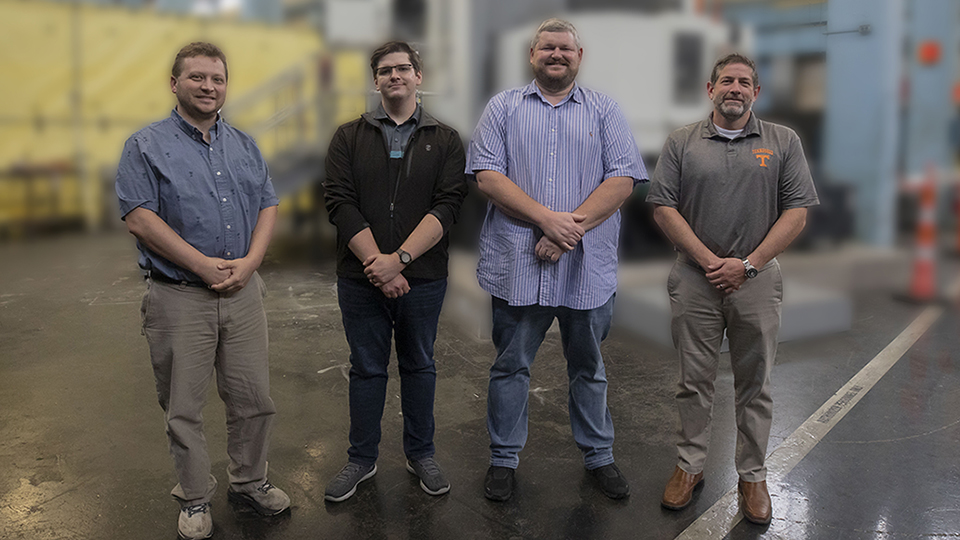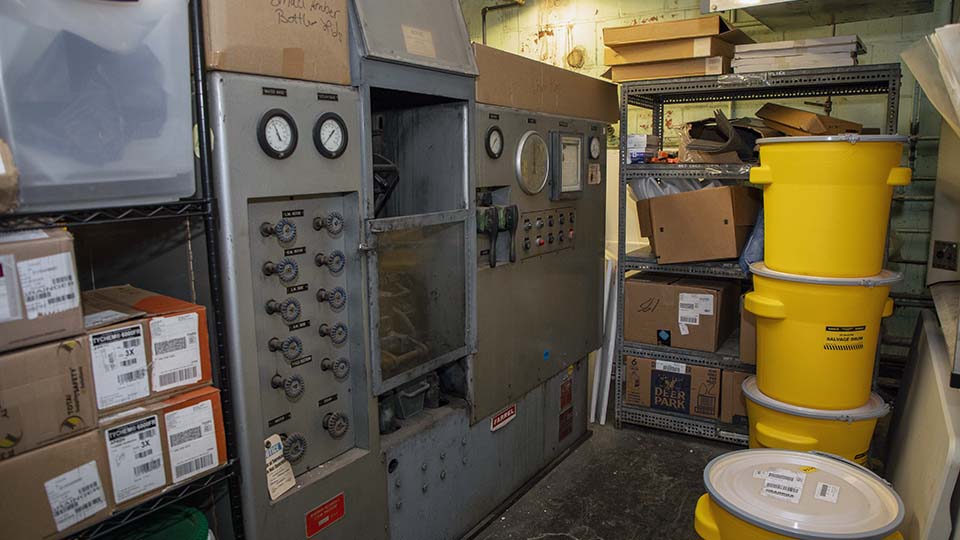A key principle at Y‑12 is continuous improvement — one of 11 principles that reflect the site’s commitment to being a learning organization. Twice a year, the Performance Improvement group asks Y‑12 organizations to submit projects to be included in its “Continuous Improvement Celebration.” There, each team shares its successes, and employees vote for the Best Y‑12 Initiative and Best Value Stream Element Teams Initiative.
This year’s recent celebration included 14 projects — 10 Y‑12 initiatives and 4 VSET initiatives.

The Tooling Project Team pictured standing in front of a machine on the shop floor.
The Best Y‑12 Initiative: The Tooling Project Team
The Tooling Project Team, comprised of Jeremy P., Adam F., Brian F., and Bill T., worked proactively to identify and mitigate problems with the tooling production system, which supports the Master Production Schedule. The Master Production Schedule is based on demand from Y‑12’s external customers and is used to align shop floor schedules across all production facilities on‑site, allowing major production deliverables to be met on time.
The group noticed that there were challenges concerning data integrity, priority management and integration, and communication between stakeholders. These challenges had been preventing Y‑12 from reliably aligning the shop floor schedule with the master schedule. As a result, the site faced a risk of production delays due to tooling not being delivered on time.
The team acknowledged these challenges and standardized schedule priority integration for tooling orders. To further monitor and improve their capacity for tooling movement, they created a visual dashboard to communicate scope and schedule data to all stakeholders and created a system of metrics and key performance indicators for the tooling production system.
The results of their work brought 15% fewer hours spent in tooling manufacturing labor despite an 82% increase in volume of tooling produced compared to the prior fiscal year. Other benefits included:
- A $44.7M return on investment as a result of increased manufacturing throughput
- A reduction of risk to program schedules, specifically risk regarding tooling readiness
- A compilation of current and historical data and metrics to be used for tracking, analytics, forecasting, and estimates
The team’s new tooling scheduling has enabled General Manufacturing to be integrated into the master schedule of site deliverables for the first time.
“This project provided a lesson learned moving forward,” Adam, a recent graduate from the Y‑12 — University of Tennessee Master’s Cohort program for Systems Engineering, said. “We can now prioritize the consistent flow of information and shared understanding of priority, enabling the shop floor to focus on fulfillment of orders and reduce disruptions in product flow.”
Adam also presented the project as his capstone project in the UT program.
“It was a great experience to apply the material from my coursework to the project,” Adam said. “The human factor — focused approach to systems engineering is something I will continue to use in my career from now on. I am proud to contribute to the mission, and I feel obliged to do whatever I can within my influence to improve our ability as a site to do so.”
Team member Jeremy said, “I view continuous improvement as paramount to our mission because each year, we are asked to do more and more as a site. If we do not make changes, we will be unable to keep up with demand in the coming years.”
The Best VSET Initiative Winner: Beta 2 Operators Reorganization Team
Marcus M. and his team “saw a need and took initiative” and was named the Best VSET Initiative across the site.
The team identified a problem with the organization of their supply room. Due to the room often being unorganized, it was difficult for employees to find consumables in a timely manner and know when to place reorders.
“I think it’s great that our team was a winner,” Marcus said. “A lot of hours went into making this storage room what it is today, and I couldn’t have done it without the help of many operators. At one point, there were over 20 people who helped with this project.”
|
1. Sort 2. Set in order 3. Shine 4. Standardize 5. Sustain |
Marcus and the team used 5S, a methodology that results in a workplace that is well organized, free of unneeded items, safe, and conducive to high quality outputs. The reorganization team sorted and disposed of unneeded items, set in order every item that is needed in a way that supports operations, and implemented a Kanban system to sustain the progress made. A Kanban system is an inventory control system that uses visual cues, like cards, to manage production and indicate when more supplies need to be ordered.
“Our team learned the value of Y‑12’s Clean Sweep program and the importance of visual management,” Marcus said. “These two tools allowed us to dispose of unneeded items and learn a new system that leads to operators actually taking pride in this room now.”
This team’s efforts saved 73 hours annually spent on looking for consumables.
“You know you started something great when people want to become involved, and that’s great,” Marcus said. “Operators have taken initiative to help improve and finish up certain jobs to ensure that the room stays organized. Continuous improvement allows workers on the frontline to have a say in how their work atmosphere is maintained. It inspires growth, and growth is good.”

The unorganized supply room before the team of operators took the initiative to make it more efficient.